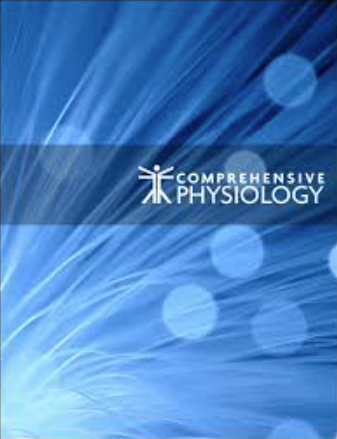Andrée-Anne Marcoux, Laurence E Tremblay, Samira Slimani, Marie-Jeanne Fiola, Fabrice Mac-Way, Ludwig Haydock, Alexandre P Garneau, Paul Isenring
求助PDF
{"title":"亨利氏袢的解剖生理学:着重于粗大的上升肢。","authors":"Andrée-Anne Marcoux, Laurence E Tremblay, Samira Slimani, Marie-Jeanne Fiola, Fabrice Mac-Way, Ludwig Haydock, Alexandre P Garneau, Paul Isenring","doi":"10.1002/cphy.c210021","DOIUrl":null,"url":null,"abstract":"<p><p>The loop of Henle plays a variety of important physiological roles through the concerted actions of ion transport systems in both its apical and basolateral membranes. It is involved most notably in extracellular fluid volume and blood pressure regulation as well as Ca<sup>2+</sup> , Mg<sup>2+</sup> , and acid-base homeostasis because of its ability to reclaim a large fraction of the ultrafiltered solute load. This nephron segment is also involved in urinary concentration by energizing several of the steps that are required to generate a gradient of increasing osmolality from cortex to medulla. Another important role of the loop of Henle is to sustain a process known as tubuloglomerular feedback through the presence of specialized renal tubular cells that lie next to the juxtaglomerular arterioles. This article aims at describing these physiological roles and at discussing a number of the molecular mechanisms involved. It will also report on novel findings and uncertainties regarding the realization of certain processes and on the pathophysiological consequences of perturbed salt handling by the thick ascending limb of the loop of Henle. Since its discovery 150 years ago, the loop of Henle has remained in the spotlight and is now generating further interest because of its role in the renal-sparing effect of SGLT2 inhibitors. © 2022 American Physiological Society. Compr Physiol 12:1-21, 2022.</p>","PeriodicalId":10573,"journal":{"name":"Comprehensive Physiology","volume":"12 1","pages":"3119-3139"},"PeriodicalIF":4.2000,"publicationDate":"2021-12-29","publicationTypes":"Journal Article","fieldsOfStudy":null,"isOpenAccess":false,"openAccessPdf":"","citationCount":"2","resultStr":"{\"title\":\"Anatomophysiology of the Henle's Loop: Emphasis on the Thick Ascending Limb.\",\"authors\":\"Andrée-Anne Marcoux, Laurence E Tremblay, Samira Slimani, Marie-Jeanne Fiola, Fabrice Mac-Way, Ludwig Haydock, Alexandre P Garneau, Paul Isenring\",\"doi\":\"10.1002/cphy.c210021\",\"DOIUrl\":null,\"url\":null,\"abstract\":\"<p><p>The loop of Henle plays a variety of important physiological roles through the concerted actions of ion transport systems in both its apical and basolateral membranes. It is involved most notably in extracellular fluid volume and blood pressure regulation as well as Ca<sup>2+</sup> , Mg<sup>2+</sup> , and acid-base homeostasis because of its ability to reclaim a large fraction of the ultrafiltered solute load. This nephron segment is also involved in urinary concentration by energizing several of the steps that are required to generate a gradient of increasing osmolality from cortex to medulla. Another important role of the loop of Henle is to sustain a process known as tubuloglomerular feedback through the presence of specialized renal tubular cells that lie next to the juxtaglomerular arterioles. This article aims at describing these physiological roles and at discussing a number of the molecular mechanisms involved. It will also report on novel findings and uncertainties regarding the realization of certain processes and on the pathophysiological consequences of perturbed salt handling by the thick ascending limb of the loop of Henle. Since its discovery 150 years ago, the loop of Henle has remained in the spotlight and is now generating further interest because of its role in the renal-sparing effect of SGLT2 inhibitors. © 2022 American Physiological Society. Compr Physiol 12:1-21, 2022.</p>\",\"PeriodicalId\":10573,\"journal\":{\"name\":\"Comprehensive Physiology\",\"volume\":\"12 1\",\"pages\":\"3119-3139\"},\"PeriodicalIF\":4.2000,\"publicationDate\":\"2021-12-29\",\"publicationTypes\":\"Journal Article\",\"fieldsOfStudy\":null,\"isOpenAccess\":false,\"openAccessPdf\":\"\",\"citationCount\":\"2\",\"resultStr\":null,\"platform\":\"Semanticscholar\",\"paperid\":null,\"PeriodicalName\":\"Comprehensive Physiology\",\"FirstCategoryId\":\"3\",\"ListUrlMain\":\"https://doi.org/10.1002/cphy.c210021\",\"RegionNum\":2,\"RegionCategory\":\"医学\",\"ArticlePicture\":[],\"TitleCN\":null,\"AbstractTextCN\":null,\"PMCID\":null,\"EPubDate\":\"\",\"PubModel\":\"\",\"JCR\":\"Q1\",\"JCRName\":\"PHYSIOLOGY\",\"Score\":null,\"Total\":0}","platform":"Semanticscholar","paperid":null,"PeriodicalName":"Comprehensive Physiology","FirstCategoryId":"3","ListUrlMain":"https://doi.org/10.1002/cphy.c210021","RegionNum":2,"RegionCategory":"医学","ArticlePicture":[],"TitleCN":null,"AbstractTextCN":null,"PMCID":null,"EPubDate":"","PubModel":"","JCR":"Q1","JCRName":"PHYSIOLOGY","Score":null,"Total":0}
引用次数: 2
引用
批量引用

 求助内容:
求助内容: 应助结果提醒方式:
应助结果提醒方式:


